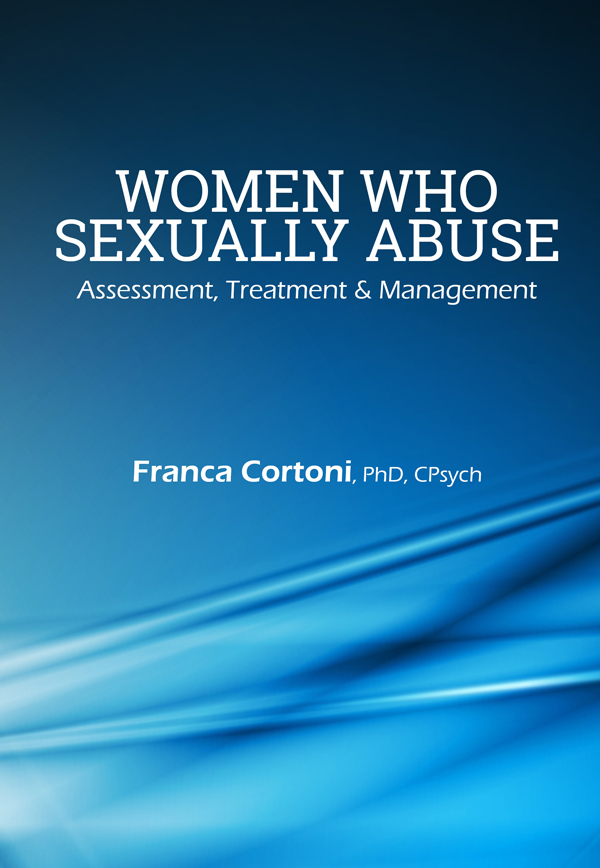Home / Shop / For Adult Clients / Professional Books for Working with Adult Clients
Women Who Sexually Abuse

- Description
- Specifications
Women Who Sexually Abuse
Assessment, Treatment & Management
by Franca Cortoni, PhD, CPsych
While female sexual offenders represent a small percentage of all those who abuse, the backgrounds, motivations, and treatment approaches for them are markedly different from those for men who abuse. There are several misconceptions surrounding why women sexually abuse, and addressing these myths is essential for successful treatment outcomes. This guidebook, written by Franca Cortoni, PhD, CPsych, a clinician with over 20 years of experience working with individuals who have committed sexual offenses, centers on these critical issues.
 Dr. Cortini explains how, unlike male sexual offenders, women who offend often have extensive victimization histories, are from lower socioeconomic backgrounds, and frequently experience financial instability. In addition, the cognitive distortions female offenders use to protect themselves from fully realizing the harm of their actions tend to be more relational and gender-role-based compared to men's distortions, which tend to be more sexually focused. For example, a common distortion for both male and female behavior is “uncontrollability,” that is, both sexes see their behavior as not under their control. However, men attribute this uncontrollability to unusually strong sexual arousal, whereas female offenders see their behavior as not under their control due to a lack of personal agency, substance abuse, or influence from a co-offender. It is essential for clinicians to understand these differences as they work with their female clients.
Dr. Cortini explains how, unlike male sexual offenders, women who offend often have extensive victimization histories, are from lower socioeconomic backgrounds, and frequently experience financial instability. In addition, the cognitive distortions female offenders use to protect themselves from fully realizing the harm of their actions tend to be more relational and gender-role-based compared to men's distortions, which tend to be more sexually focused. For example, a common distortion for both male and female behavior is “uncontrollability,” that is, both sexes see their behavior as not under their control. However, men attribute this uncontrollability to unusually strong sexual arousal, whereas female offenders see their behavior as not under their control due to a lack of personal agency, substance abuse, or influence from a co-offender. It is essential for clinicians to understand these differences as they work with their female clients.
Differences Between Male and Female Sexual Offenders
Research findings discussed by Cortini in this guidebook include:
Co-Offenders: Women tend to offend more often with co-offenders, particularly male partners, compared to men who typically offend alone.
Pedophilia: There is very little evidence that a pre-existing pedophilic sexual preference is the primary motivator at the root of women’s sexual abuse of children.
Emotional Needs: Women may engage in sexual offending to fulfill emotional needs for closeness and intimacy, to please a partner, or for instrumental reasons like revenge or financial gain.
Motivation: Women's motivations are often more related to emotional needs, relationship issues, or instrumental goals such as revenge or humiliation, rather than deviant sexual interests, which are more common in male offenders.
The Need for Gender-Specific Assessment and Treatment
Dr. Cortini devotes an entire chapter to the problem of using assessments with female offenders that were developed for men. Beyond the issue that male-based tools have not been validated for women, these tools do not consider many of the factors behind female abuse (e.g., relationship problems, victimization histories, and maladaptive coping strategies). Cortini points out that evidence-based assessment and treatment need to be used with female sexual offenders:
…within forensic psychology and criminology, there is a long-standing view that criminal behavior is gender-neutral and that what matters is the criminal behavior itself, not the gender of the offender. These arguments neglect the fact that the standards of risk assessment require that the tool be validated for the type of offender under evaluation. They also ignore the empirical evidence against their use for women.
Treatment approaches with women need to address the reasons behind the offense, which for women are frequently relationship problems, intimacy deficits, gender-specific cognitive distortions, and the dynamics that occur in co-offending relationships. Mental health issues stemming from early victimization experiences are more prevalent in female offenders and thus need to be a focus of treatment. A comprehensive assessment of the woman's life experiences and factors that led to offending is important for developing an effective treatment plan.
Whether you’re a clinician, researcher, or student, this book is an essential addition to your professional library. It’s more than just a guide—it’s a resource that enhances the understanding and treatment of women who sexually offend.
Click here to view Table of Contents, Preface, and About the Author
ISBN: 978-1-940234-10-6
179 pages, paper
$42
Order# WP192


